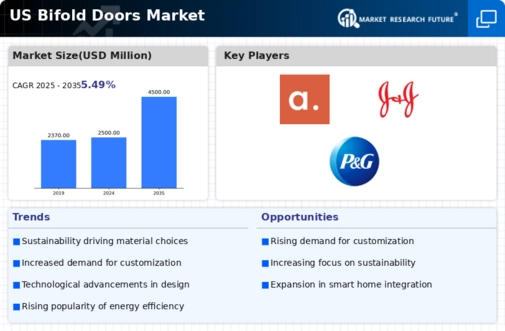Rising Demand for Energy Efficiency
The bifold doors market is experiencing a notable increase in demand for energy-efficient solutions. Homeowners and builders are increasingly prioritizing energy conservation, leading to a surge in the adoption of bifold doors that offer superior insulation and thermal performance. According to recent data, energy-efficient bifold doors can reduce heating and cooling costs by up to 30%, making them an attractive option for environmentally conscious consumers. This trend is further supported by various state and federal incentives aimed at promoting energy-efficient home improvements. As a result, the bifold doors market is likely to see sustained growth as more consumers seek to enhance their homes' energy efficiency.
Urbanization and Space Optimization
The ongoing trend of urbanization in the United States is significantly impacting the bifold doors market. As urban areas become more densely populated, the need for space optimization in residential and commercial properties is paramount. Bifold doors provide a practical solution by allowing for seamless transitions between indoor and outdoor spaces, thus maximizing usable area. This trend is particularly evident in metropolitan regions where property sizes are smaller. The bifold doors market is poised to benefit from this shift, as architects and designers increasingly incorporate bifold doors into their projects to create open, airy environments that appeal to modern consumers.
Increased Home Renovation Activities
The bifold doors market is witnessing a boost due to the rising trend of home renovation activities across the United States. Homeowners are increasingly investing in upgrades to enhance aesthetics and functionality, with bifold doors being a popular choice for creating open spaces and improving natural light. Recent statistics indicate that home renovation spending has increased by approximately 15% over the past year, reflecting a growing willingness to invest in home improvements. This trend is likely to continue, as more individuals recognize the value of bifold doors in transforming their living spaces. Consequently, the bifold doors market is expected to thrive as renovation projects become more prevalent.
Growing Interest in Outdoor Living Spaces
The bifold doors market is benefiting from a growing interest in outdoor living spaces among American homeowners. As people seek to expand their living areas into the outdoors, bifold doors offer an ideal solution for creating a seamless connection between indoor and outdoor environments. This trend is particularly pronounced in regions with favorable climates, where outdoor entertaining and relaxation are highly valued. The bifold doors market is likely to see increased demand as homeowners invest in features that enhance their outdoor experiences, such as patios and decks that integrate with bifold door systems.
Technological Innovations in Door Manufacturing
The bifold doors market is being influenced by technological innovations in door manufacturing processes. Advances in materials and production techniques have led to the development of more durable, lightweight, and aesthetically pleasing bifold doors. Innovations such as improved weather sealing and enhanced locking mechanisms are making bifold doors more appealing to consumers. As manufacturers continue to invest in research and development, the bifold doors market is expected to benefit from the introduction of new products that meet evolving consumer preferences. This focus on innovation may drive market growth as consumers seek high-quality, reliable bifold door solutions.














Leave a Comment